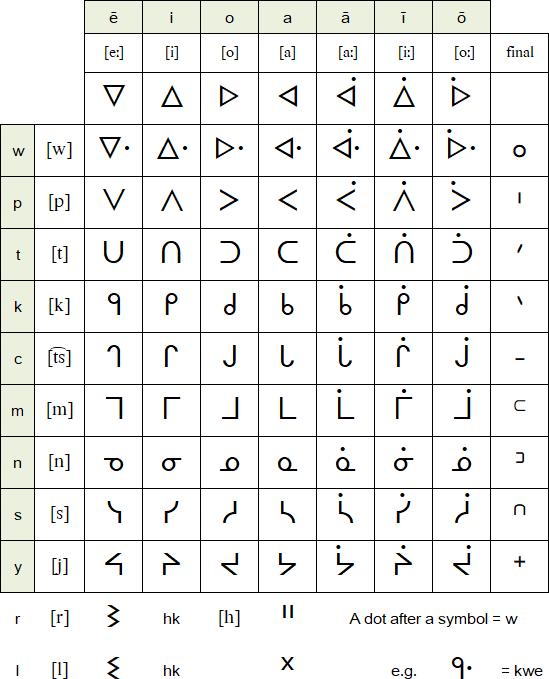(ᓀᐦᐃᔭᐍᐏᐣ)
Origin
James Evans, a Wesleyan missionary working at Norway House in Hudson's Bay, invented a syllabary for the Ojibwe language in about 1840. He had tried to produce a Latin-based orthography for Ojibwe, but eventually gave up and came up with a syllabary, based partly on shorthand.Evans' syllabary for Ojibwe consisted of just nine symbols, each of which could be written in four different orientations to indicate different vowels. This was sufficient to write Ojibwe, but Evans' superiors were not keen on his invention and would not allow him to use it.
About 20 years later, Evans learnt to speak Cree and set about the task of devising a way of writing that language. After encountering difficulties with using the Latin alphabet, he dug out his Ojibwe syllabary and adapted it to the Cree language.
Thanks to its simplicity and the ease with which it could be learnt, the Cree syllabary was hugely successful with the Cree people. Within a short space of time, virtually the whole community was literate in the syllabary and James Evans became known as "the man who made birchbark talk."
Source: www.nlc-bnc.ca/north/index-e.html
According to Cree tradition, Evans adapted an existing script which was invented at an earlier date, possibly by a member of the Blackfoot nation.
Notable Features
- Type of writing system: syllabary
- Direction of writing: left to right in horizontal lines
- Each sign can be written facing four different directions which indicate the vowel attached to it. As there are up to 7 vowels in some dialects of Cree, diacritics are used to indicate the extra vowels
- The finals are used to write stand-alone consonants
- There are various different versions of the Cree syllabary, which are used to write different dialects of the Cree language.
Used to write
Cree, (Nēhiyawēwin / ᓀᐦᐃᔭᐍᐏᐣ) a group of closely related Algonquian languages spoken by about 60,000 people in Canada, especially in Ontario, Manitoba, Saskatchewan and Alberta.Major varieties include:
- Central Cree (York Cree, West Shore Cree, West Main Cree)
with 4,500 speakers.
Dialects include: Moose Cree, which is spoken in the southern tip of James Bay in Moosonee, Ontario, and Swampy Cree, which is spoken northwestward across Ontario into north-eastern Manitoba. - Coastal Eastern Cree (Coastal Cree, Eastern Coastal Cree) is spoken by about 5,000 people in Quebec on the east coast of James Bay.
- Inland Eastern Cree (Inland Cree, Eastern Inland Cree) has about 2,200 speakers in Quebec.
- Western Cree with about 53,000 speakers in the USA and
in north central Manitoba and Saskatchewan, Canada.
Dialects include: Woods Cree, Plains Cree and Western Swampy Cree.
Cree syllabary (Plains/Swampy Cree)

Cree syllabary (Woodland Cree)

Sample text in Swampy Cree

Transliteration
misiwe ininiw tipenimitisowinik eshi nitawikit nesta peywakan kici ishi kanawapamikiwisit kistenimitisowinik nesta minikowisiwima. e pakitimamacik kaketawenitamowininiw nesta mitonenicikaniniw nesta wicikwesitowinik kici ishi kamawapamitocik.
Translation
All human beings are born free and equal in dignity and rights. They are endowed with reason and conscience and should act towards one another in a spirit of brotherhood.(Article 1 of the Universal Declaration of Human Rights)
Language learning materials for Cree
Links
Information on the Cree language and peoplehttp://www.creeculture.ca
http://en.wikipedia.org/wiki/Cree_language
http://www.native-languages.org/cree.htm
Speak Cree - links to Cree language learning resources
http://www.nisto.com/cree
Cree Syllabics Tutor
http://io.acad.athabascau.ca/~jelica/projects/phptutor/
Universal Syllabic Translator
http://www.nehiyo.com
Online Cree dictionary
http://www.creedictionary.com
Cree fonts
http://www.wazu.jp/gallery/Fonts_Cree.html
Information about Plains, Swampy and Woodland Cree
http://www.sicc.sk.ca/heritage/sils/ourlanguages/cree.html
Cree Language Reader - texts in Cree with translations in English
http://nexus.brocku.ca/rogawa/cree/
East Cree interactice grammar
http://www.carleton.ca/ecree/en/
Plains Cree lessons
http://198.161.103.254/nipisihkopahk/









.jpg)
.jpg)

.jpg)





0 comments:
Post a Comment
Note: Only a member of this blog may post a comment.